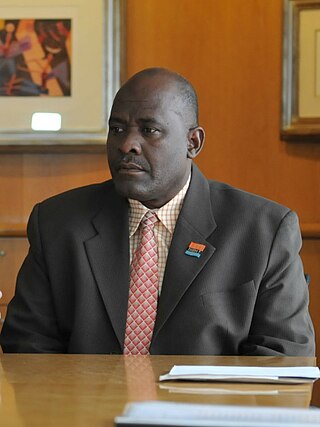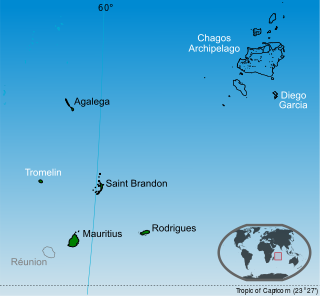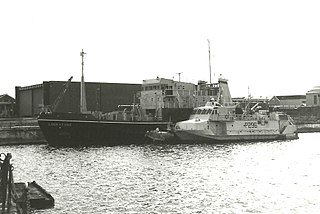Related Research Articles

Diego Garcia is the largest island of the Chagos Archipelago, part of the British Indian Ocean Territory (BIOT). It has been used as a joint UK–U.S. military base since the 1970s, following the expulsion of the Chagossians by the UK government. The Chagos Islands have been a British overseas territory, but in early October 2024, the UK agreed to transfer sovereignty of the islands to Mauritius, while allowing the military base to remain under a 99-year lease, pending a treaty ratification.

Mauritius, officially the Republic of Mauritius, is an island country in the Indian Ocean, about 2,000 kilometres off the southeastern coast of East Africa, east of Madagascar. It includes the main island, as well as Rodrigues, Agaléga, and St. Brandon. The islands of Mauritius and Rodrigues, along with nearby Réunion, are part of the Mascarene Islands. The main island of Mauritius, where the population is concentrated, hosts the capital and largest city, Port Louis. The country spans 2,040 square kilometres (790 sq mi) and has an exclusive economic zone covering 2,300,000 square kilometres.

The Chagos Archipelago or Chagos Islands is a group of seven atolls comprising more than 60 islands in the Indian Ocean about 500 kilometres (310 mi) south of the Maldives archipelago. This chain of islands is the southernmost archipelago of the Chagos–Laccadive Ridge, a long submarine mountain range in the Indian Ocean. In its north are the Salomon Islands, Nelsons Island and Peros Banhos; towards its south-west are the Three Brothers, Eagle Islands, Egmont Islands and Danger Island; southeast of these is Diego Garcia, by far the largest island. All are low-lying atolls, save for a few extremely small instances, set around lagoons.

The Chagossians are an Afro-Asian ethnic group originating from freed African slaves brought to the Chagos Islands, specifically Diego Garcia, Peros Banhos, and the Salomon island chain, in the late 18th century as well as people of Asian descent. Under international law, they are the indigenous people of the Chagos archipelago. Most Chagossians now live in Mauritius, Seychelles, and the United Kingdom after being forcibly removed by the British government in the late 1960s and early 1970s so that Diego Garcia, the island where most Chagossians lived, could serve as the location for a United States military base. Today, no Chagossians are allowed to live on the island of Diego Garcia or anywhere in the Chagos archipelago, despite many of the islands they used to inhabit being over 160 kilometres (99 mi) away from Diego Garcia.
The United Kingdom, at the request of the United States, began expelling the inhabitants of the Chagos Archipelago in 1968, concluding its forced deportations on 27 April 1973 with the expulsion of the remaining Chagossians on the Peros Banhos atoll. The inhabitants, known at the time as the Ilois, are today known as Chagos Islanders or Chagossians.
Mauritian Creoles are the people on the islands of Mauritius, Rodrigues, Agaléga and the Chagos Archipelago and in the wider overseas Mauritian diaspora who trace their roots to continental Africans who were brought to Mauritius under slavery from the seventeenth to the nineteenth century. The majority of these enslaved people came from the region in and around modern day Mozambique and Madagascar. Creole peoples can be found on other islands in the Mascarene Islands and these groups all share cultural and linguistic connections with one another stemming from the common heritage of their African ancestors. It can also refer to and include Christian members of the country's mixed race community. In government records, creoles along with Franco-Mauritians form part of the broader group known as Population Générale.
The UNROW Human Rights Impact Litigation Clinic is a student litigation and advocacy project at American University's Washington College of Law.

The British Indian Ocean Territory (BIOT) is an Overseas Territory of the United Kingdom situated in the Indian Ocean, halfway between Tanzania and Indonesia. The territory comprises the seven atolls of the Chagos Archipelago with over 1,000 individual islands, many very small, amounting to a total land area of 60 square kilometres. The largest and most southerly island is Diego Garcia, 27 square kilometres, the site of a Joint Military Facility of the United Kingdom and the United States. Official administration is remote from London, though the local capital is often regarded as being on Diego Garcia.

Louis Olivier Bancoult is a Chagossian activist for the right of return and the leader of the Chagos Refugee Group (CRG).

Sovereignty over the Chagos Archipelago is disputed between Mauritius, Maldives and the United Kingdom. Mauritius has repeatedly stated that the Chagos Archipelago is part of its territory and that the United Kingdom claim is a violation of United Nations resolutions banning the dismemberment of colonial territories before independence. On 22 May 2019, the United Nations General Assembly adopted a non-binding resolution declaring that the archipelago was part of Mauritius; 116 countries voted in favour of Mauritius while six opposed it.

The UK Chagos Support Association is an organisation based in the United Kingdom that supports the Chagossian people in advocacy activities and to improve the welfare of Chagossian people in the UK. Its patrons include Ben Fogle and Benjamin Zephaniah. In 2020 it worked with Mauritian-Chagossian artist Audrey Albert.

The Chagos Marine Protected Area, located in the central Indian Ocean in the British Indian Ocean Territory of the United Kingdom, is one of the world's largest officially designated marine protected areas, and one of the largest protected areas of any type on Earth. It was established by the British government on 1 April 2010 as a massive, contiguous, marine reserve, it encompasses 640,000 square kilometres (250,000 sq mi) of ocean waters, including roughly 70 small islands and seven atolls of the Chagos Archipelago.
Amy Jenkins is an American artist from Peterborough, New Hampshire who is recognized for her work in video installation and experimental film.
Aurélie Marie-Lisette Talate, also known as Lisette Talate or Aurelie Talate in her community was a Chagossian activist and emblematic figure of the Chagossian struggle to regain their islands; which they were forcibly exiled from by the occupying US military with permission from the UK in order to establish the Diego Garcia military base. Despite strong desire from the community to return to their land, the US and UK governments have patently refused to allow right of return.

RMAS Lodestone (A115) was a Magnet-class Royal Navy degaussing ship. She was completed in 1980 by the Clelands Shipbuilding Company.
Sabrina Jean is a second-generation Chagossian and activist for the Chagossian community to return home to the Chagos Islands in the Indian Ocean, administered as part of the British Indian Ocean Territory.

Sega tambour Chagos is one of the types of Sega music of Mauritius, with origins in the Chagos Archipelago. It is sung in the Chagossian creole language of the islands.
Clément Siatous is a Mauritian and British painter of Chagossian origin. He is known for his paintings depicting the daily life of the Chagossians before their exile.
Jessy Marcelin is a Chagossian musician and activist who was born in the Chagos Islands and forced to leave as part of Britain's displacement of the Chagossian people.
Liseby Elysé is a Mauritian activist of Chagossian origin. She is known for her testimony before the International Court of Justice in 2019 in the case between Mauritius and the United Kingdom concerning sovereignty over the Chagos Archipelago.
References
- 1 2 "Audrey Albert (artiste photographe) : « Il faut plus de visibilité pour la communauté chagossienne »". Le Mauricien (in French). Retrieved 2022-05-03.
- 1 2 "About". Audrey Albert. Retrieved 2022-05-03.
- ↑ "Audrey Albert – Manchester School of Art Degree Show 2018". Manchester School of Art. Retrieved 2022-05-03.
- 1 2 3 House, Manchester International Festival Blackfriars. "MIF21 Creative Fellowships". Manchester International Festival. Retrieved 2022-05-03.
- ↑ "Audrey Albert: Future Fire 2020". Contact. 2020-04-09. Retrieved 2022-05-03.
- ↑ "Chagos: A people's fight for their rights". Luxury Indian Ocean I The Epitome of Luxury in the Indian Ocean. 2018-12-12. Retrieved 2022-05-03.
- ↑ "Matter Out of Place". phmuseum.com. Retrieved 2022-05-03.
- ↑ "Send season's greetings that support Chagossians". chagos-support. 2020-11-17. Retrieved 2022-05-03.
- ↑ "Jongeren bereiken vraagt radicale keuzes". publiq (in Dutch). Retrieved 2022-05-03.